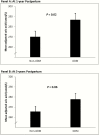Changes Over Time in Uric Acid in Relation to Changes in Insulin Sensitivity, Beta-Cell Function, and Glycemia
- PMID: 31720687
- PMCID: PMC7025949
- DOI: 10.1210/clinem/dgz199
Changes Over Time in Uric Acid in Relation to Changes in Insulin Sensitivity, Beta-Cell Function, and Glycemia
Abstract
Context: Serum uric acid has been linked to risk of type 2 diabetes (T2DM), but debate persists as to whether it plays a causal role. Indeed, it is unclear if changes in uric acid relate to the pathophysiologic determinants of T2DM (insulin resistance, beta-cell dysfunction), as would be expected if causal.
Objective: To evaluate the impact of changes in uric acid over 2 years on changes in insulin sensitivity, beta-cell function, and glycemia in women with and without recent gestational diabetes (GDM), a model of the early natural history of T2DM.
Design/setting/participants: At both 1 and 3 years postpartum, 299 women (96 with recent GDM) underwent uric acid measurement and oral glucose tolerance tests that enabled assessment of insulin sensitivity/resistance (Matsuda index, homeostasis model assessment of insulin resistance [HOMA-IR]), beta-cell function (insulin secretion-sensitivity index-2 [ISSI-2], insulinogenic index/HOMA-IR [IGI/HOMA-IR]), and glucose tolerance.
Results: Women with recent GDM had higher serum uric acid than their peers at both 1 year (281 ± 69 vs 262 ± 58 µmol/L, P = 0.01) and 3 years postpartum (271 ± 59 vs 256 ± 55 µmol/L, P = 0.03), coupled with lower insulin sensitivity, poorer beta-cell function, and greater glycemia (all P < 0.05). However, on fully adjusted analyses, neither uric acid at 1 year nor its change from 1 to 3 years was independently associated with any of the following metabolic outcomes at 3 years postpartum: Matsuda index, HOMA-IR, ISSI-2, IGI/HOMA-IR, fasting glucose, 2-hour glucose, or glucose intolerance.
Conclusion: Serum uric acid does not track with changes over time in insulin sensitivity, beta-cell function, or glycemia in women with recent GDM, providing evidence against causality in its association with diabetes.
Keywords: beta-cell dysfunction; gestational diabetes; insulin resistance; type 2 diabetes; uric acid.
© Endocrine Society 2019. All rights reserved. For permissions, please e-mail: journals.permissions@oup.com.
Figures

References
-
- Bailey CJ. Uric acid and the cardio-renal effects of SGLT2 inhibitors. Diabetes Obes Metab. 2019;21(6):1291–1298. - PubMed
-
- Shani M, Vinker S, Dinour D, et al. . High normal uric acid levels are associated with an increased risk of diabetes in lean, normoglycemic healthy women. J Clin Endocrinol Metab. 2016;101(10):3772–3778. - PubMed
Publication types
MeSH terms
Substances
Grants and funding
LinkOut - more resources
Full Text Sources
Medical

